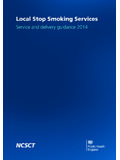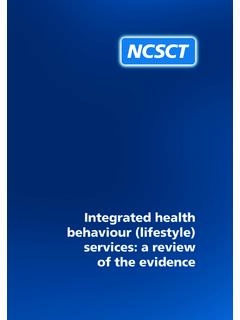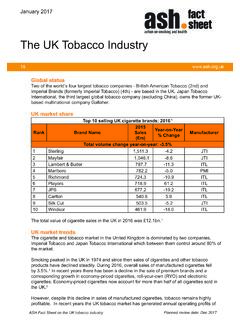Transcription of Incorporating e-cigarettes into your Stop Smoking Service
1 Produced in conjunction with the Office for Health Improvement and DisparitiesIncorporating e- cigarettes into your Stop Smoking Service : Making the case and addressing concernsNCSCT| | December 20212 PurposeThe purpose of this document is to help English stop Smoking services to make e- cigarettes (vapes) available to their clients. It makes the case for providing e- cigarettes as an option for your clients alongside medicinally licenced stop Smoking products, addresses common misconceptions and concerns, and offers a checklist for the types of things to consider when deciding how your Service will provide clients with access to vaping products. BackgroundExpert support from a local stop Smoking Service (LSSS) gives smokers the best chance of quitting for good. Depending on the area, services can be based in a range of settings including integrated lifestyle services, community pharmacies and GP surgeries. Stop Smoking services are free and offer a choice of one-to-one or group behavioural support from a trained stop Smoking advisor together with effective quitting evidence shows that while nicotine is the addictive substance in cigarettes , it is relatively harmless and nicotine-containing products are effective for Smoking cessation.
2 In fact, almost all the harm from Smoking comes from the thousands of other chemicals in tobacco smoke, many of which are toxic. Despite this: 4 in 10 smokers and ex-smokers incorrectly think nicotine causes most Smoking -related cancer of smokers have never tried vaping, and one reason is that 32% think that it s more harmful than Smoking Advising smokers on the relative risks of nicotine-containing products compared to smoked tobacco is an integral part of supporting them to quit. The National Institute for Health and Care Excellence (NICE) have produced updated guidance on Tobacco: preventing uptake, promoting quitting and treating dependence (NICE guidance NG209, 2021). This includes advice on the use of e- cigarettes to help people to stop Smoking or reduce their harm from Health England s Vaping in England Evidence Review (2021) finds that there is strong evidence that nicotine vaping products are effective for Smoking cessation and reduction.
3 Combining vaping products (the most popular source of support used by people making a quit attempt in the general population) with stop Smoking Service support (the most effective type of support) should be an option available to all people who want to quit smokingAn ASH survey of tobacco control leads found that one in ten local authority stop Smoking services already offer vaping products to some or all people making a quit | | December 20213 Why services should offer e-cigarettesE- cigarettes are effective stop Smoking aidsA major UK clinical trial found e- cigarettes , when combined with face-to-face behavioural support, to be twice as effective, and one fifth of the cost, for quitting Smoking as other nicotine replacement products such as patches or gum. Involving nearly 900 participants, it found that in LSSS, a simple tank-style e-cigarette was twice as effective at helping smokers to quit compared with a combination NRT.
4 Both groups were provided with behavioural support and those in the e-cigarette group, in addition to superior quit rates, were also noted to have reductions in cough and phlegm when surveyed at 12 months. E- cigarettes are a popular method of quittingE- cigarettes are the most popular stop Smoking aid in England, with an estimated to million adult users in 2020. Over half (51%) have stopped Smoking completely and of the 45% who still smoke, half say that they are vaping in order to stop Smoking . The number who have quit Smoking and vaping has reached 770, following are the main findings from nationally representative survey data (STS).1. Using a vaping product is the most popular aid used by people trying to quit Smoking . In 2020, of people used a vaping product in a quit attempt in the previous 12 months; this is more than those who used NRT over the counter ( ) or on prescription ( ), and who used varenicline ( ).
5 2. Vaping is positively associated with quitting Smoking successfully. In 2017, over 50,000 smokers stopped Smoking with a vaping product who would otherwise have carried on Prescription medication and licensed NRT for harm reduction were also positively associated with successfully quitting Smoking . This shows how important it is for people who smoke to have access to a wide choice of cessation The extensive use of vaping products in quit attempts compared with licensed medication suggests vaping products may reach more people who smoke and so have more impact than NRT and Frequent use of e- cigarettes is more strongly associated with successful quitting of | | December 20214 Stop Smoking services are seeing positive quit rates when using e-cigarettesThe following are the main findings from English stop Smoking services Between April 2019 and March 2020, 221,678 quit dates were set with a stop Smoking Service and 114,153 (51%) of these led to self-reported quits 4 weeks after the quit A vaping product was used in of quit attempts.
6 This was either using the vaping product alone or at the same time as, or following use of, a licensed medication (ranging from 15% in the East Midlands to in Yorkshire & Humber). In 2019/20, Leicestershire stop Smoking Service saw the highest proportion of clients using an e-cigarette as part of their quit attempt ( ). Leicestershire stop Smoking Service as a whole achieved 68% 4-week success rates last year, placing them in the top decile nationally for quit Consistent with findings in previous years, the highest quit rates (74%) were seen when the quit attempt involved people using a licensed medicine and a vaping product one after Quit rates were similar for people using a vaping product and licensed medication at the same time ( ), a vaping product alone ( ) and varenicline alone ( ). The quit rates for single NRT and combination NRT were and rates involving a vaping product were higher than any other method in every region in England.
7 These ranged from 49% in the South West to 78% in Yorkshire and the important limitation of the LSSS data is that it is observational and it is possible that the people using a vaping product alone or in combination with licensed stop Smoking medicines may differ in their demographic, clinical and Smoking characteristics, from people making a quit attempt with licensed medication only or those who only opt for behavioural support. Studies suggest that LSSS advisors willing to support the use of e- cigarettes for Smoking cessation tend to be better trained and more experienced than average. It may also be that quitters willing to use an e-cigarette and access support from their LSSS may be more than usually highly motivated. If this is the case, then the combination of the most experienced advisors and the most motivated of quitters would be expected to achieve greater success and this may explain why those who use e- cigarettes and NRT consecutively rather than concurrently have the highest success rates, signalling a willingness to adapt strategies.
8 Notwithstanding these factors, LSSS data is remarkably consistent with peer reviewed studies, including a Cochrane | | December 20215 Are they safe?E- cigarettes aren t risk free but carry a fraction of the risk of Smoking and are helping thousands of smokers to quit and stay health and public health organisations including the Royal College of General Practitioners (RCGP), British Medical Association (BMA), Cancer Research UK and the US National Academies of Sciences, Engineering and Medicine (NASEM) and Public Health England agree, based on available evidence, that although not risk-free, e- cigarettes are far less harmful than Medical Association: There is growing consensus that using an e-cigarette is substantially safer than Smoking tobacco. Unlike Smoking , e-cigarette use does not involve combustion. While the constituents of e-cigarette vapour can vary, and some of the toxicants present in tobacco smoke have been detected in e-cigarette aerosol, they are typically present at levels which are much lower than in tobacco guideline NG209 provides recommendations for people who provide stop Smoking support or advice to adults.
9 It advises on giving clear, consistent and up-to-date information on nicotine-containing e- cigarettes to adults who are interested in using them to stop independent HMG Committee on Toxicity of Chemicals in Food, Consumer Products and the Environment (COT) reports that although e- cigarettes pose some health risk, these are expected to be much less than from continuing to smoke. This supports PHE s position that e- cigarettes should only be used as a stop Smoking aid. The report also states that risk to bystanders from ambient exposure to vaping is likely to be Alan Boobis, Chair of the COT, said Our assessment on e- cigarettes largely reinforces the scientific consensus to date on their relative safety, that while not without risk they are significantly less harmful than Smoking .NCSCT| | December 20216E- cigarettes in the UK are regulatedThe UK has some of the strictest regulation for e- cigarettes in the world.
10 Under the Tobacco and Related Products Regulations 2016, e-cigarette products are subject to minimum standards of quality and safety, as well as packaging and labelling requirements to provide consumers with the information they need to make informed products must be notified by manufacturers to the UK Medicines and Healthcare products Regulatory Agency (MHRA), with detailed information including the listing of all ingredients. The e-cigarette or vaping use-associated lung injury (EVALI) outbreak in the United StatesOn 25 February 2020, the US Center for Disease Control and Prevention (CDC) published its final update (27) on the number of hospitalised cases and deaths nationally. It concluded that e- cigarettes per se were not the cause of the outbreak: tetrahydrocannabinol (THC)- containing e-cigarette, or vaping products, particularly from informal sources like friends, family, or in-person or online dealers, are linked to most EVALI cases and play a major role in the outbreak and Vitamin E acetate is strongly linked to the EVALI outbreak.
![e-cigarettes briefing [ 2 ] v4 - NCSCT](/cache/preview/0/6/5/c/9/3/f/f/thumb-065c93ffb7496a6f7f874369520a6a6d.jpg)














